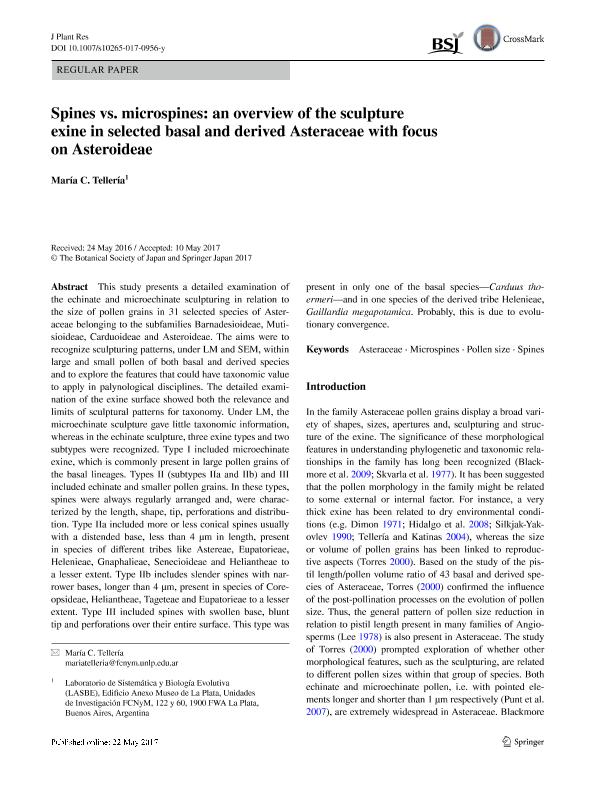Artículo
Spines vs. microspines: an overview of the sculpture exine in selected basal and derived Asteraceae with focus on Asteroideae
Fecha de publicación:
11/2017
Editorial:
Springer Tokyo
Revista:
Journal of Plant Research
ISSN:
0918-9440
Idioma:
Inglés
Tipo de recurso:
Artículo publicado
Clasificación temática:
Resumen
This study presents a detailed examination of the echinate and microechinate sculpturing in relation to the size of pollen grains in 31 selected species of Asteraceae belonging to the subfamilies Barnadesioideae, Mutisioideae, Carduoideae and Asteroideae. The aims were to recognize sculpturing patterns, under LM and SEM, within large and small pollen of both basal and derived species and to explore the features that could have taxonomic value to apply in palynological disciplines. The detailed examination of the exine surface showed both the relevance and limits of sculptural patterns for taxonomy. Under LM, the microechinate sculpture gave little taxonomic information, whereas in the echinate sculpture, three exine types and two subtypes were recognized. Type I included microechinate exine, which is commonly present in large pollen grains of the basal lineages. Types II (subtypes IIa and IIb) and III included echinate and smaller pollen grains. In these types, spines were always regularly arranged and, were characterized by the length, shape, tip, perforations and distribution. Type IIa included more or less conical spines usually with a distended base, less than 4 µm in length, present in species of different tribes like Astereae, Eupatorieae, Helenieae, Gnaphalieae, Senecioideae and Heliantheae to a lesser extent. Type IIb includes slender spines with narrower bases, longer than 4 µm, present in species of Coreopsideae, Heliantheae, Tageteae and Eupatorieae to a lesser extent. Type III included spines with swollen base, blunt tip and perforations over their entire surface. This type was present in only one of the basal species—Carduus thoermeri—and in one species of the derived tribe Helenieae, Gaillardia megapotamica. Probably, this is due to evolutionary convergence.
Palabras clave:
Asteraceae
,
Microspines
,
Pollen Size
,
Spines
Archivos asociados
Licencia
Identificadores
Colecciones
Articulos(CCT - LA PLATA)
Articulos de CTRO.CIENTIFICO TECNOL.CONICET - LA PLATA
Articulos de CTRO.CIENTIFICO TECNOL.CONICET - LA PLATA
Citación
Tellería, María Cristina; Spines vs. microspines: an overview of the sculpture exine in selected basal and derived Asteraceae with focus on Asteroideae; Springer Tokyo; Journal of Plant Research; 130; 6; 11-2017; 1023-1033
Compartir
Altmétricas




